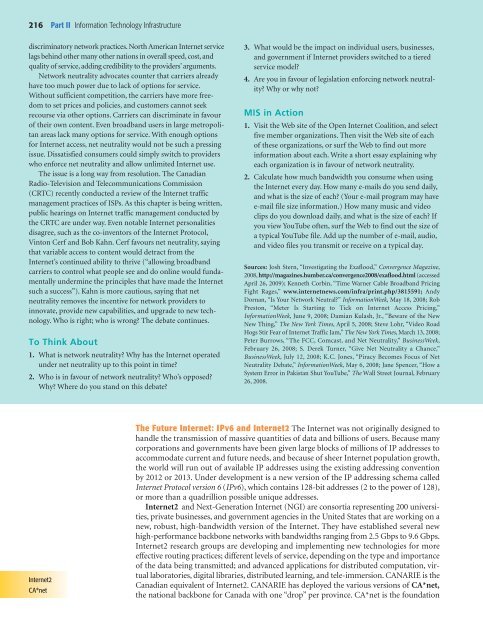Telecommunications, the Internet, and Wireless ... - Pearson Canada
Telecommunications, the Internet, and Wireless ... - Pearson Canada
Telecommunications, the Internet, and Wireless ... - Pearson Canada
Create successful ePaper yourself
Turn your PDF publications into a flip-book with our unique Google optimized e-Paper software.
216 Part II Information Technology Infrastructure<br />
discriminatory network practices. North American <strong>Internet</strong> service<br />
lags behind o<strong>the</strong>r many o<strong>the</strong>r nations in overall speed, cost, <strong>and</strong><br />
quality of service, adding credibility to <strong>the</strong> providers’ arguments.<br />
Network neutrality advocates counter that carriers already<br />
have too much power due to lack of options for service.<br />
Without sufficient competition, <strong>the</strong> carriers have more freedom<br />
to set prices <strong>and</strong> policies, <strong>and</strong> customers cannot seek<br />
recourse via o<strong>the</strong>r options. Carriers can discriminate in favour<br />
of <strong>the</strong>ir own content. Even broadb<strong>and</strong> users in large metropolitan<br />
areas lack many options for service. With enough options<br />
for <strong>Internet</strong> access, net neutrality would not be such a pressing<br />
issue. Dissatisfied consumers could simply switch to providers<br />
who enforce net neutrality <strong>and</strong> allow unlimited <strong>Internet</strong> use.<br />
The issue is a long way from resolution. The Canadian<br />
Radio-Television <strong>and</strong> <strong>Telecommunications</strong> Commission<br />
(CRTC) recently conducted a review of <strong>the</strong> <strong>Internet</strong> traffic<br />
management practices of ISPs. As this chapter is being written,<br />
public hearings on <strong>Internet</strong> traffic management conducted by<br />
<strong>the</strong> CRTC are under way. Even notable <strong>Internet</strong> personalities<br />
disagree, such as <strong>the</strong> co-inventors of <strong>the</strong> <strong>Internet</strong> Protocol,<br />
Vinton Cerf <strong>and</strong> Bob Kahn. Cerf favours net neutrality, saying<br />
that variable access to content would detract from <strong>the</strong><br />
<strong>Internet</strong>’s continued ability to thrive (“allowing broadb<strong>and</strong><br />
carriers to control what people see <strong>and</strong> do online would fundamentally<br />
undermine <strong>the</strong> principles that have made <strong>the</strong> <strong>Internet</strong><br />
such a success”). Kahn is more cautious, saying that net<br />
neutrality removes <strong>the</strong> incentive for network providers to<br />
innovate, provide new capabilities, <strong>and</strong> upgrade to new technology.<br />
Who is right; who is wrong? The debate continues.<br />
To Think About<br />
1. What is network neutrality? Why has <strong>the</strong> <strong>Internet</strong> operated<br />
under net neutrality up to this point in time?<br />
2. Who is in favour of network neutrality? Who’s opposed?<br />
Why? Where do you st<strong>and</strong> on this debate?<br />
3. What would be <strong>the</strong> impact on individual users, businesses,<br />
<strong>and</strong> government if <strong>Internet</strong> providers switched to a tiered<br />
service model?<br />
4. Are you in favour of legislation enforcing network neutrality?<br />
Why or why not?<br />
MIS in Action<br />
1. Visit <strong>the</strong> Web site of <strong>the</strong> Open <strong>Internet</strong> Coalition, <strong>and</strong> select<br />
five member organizations. Then visit <strong>the</strong> Web site of each<br />
of <strong>the</strong>se organizations, or surf <strong>the</strong> Web to find out more<br />
information about each. Write a short essay explaining why<br />
each organization is in favour of network neutrality.<br />
2. Calculate how much b<strong>and</strong>width you consume when using<br />
<strong>the</strong> <strong>Internet</strong> every day. How many e-mails do you send daily,<br />
<strong>and</strong> what is <strong>the</strong> size of each? (Your e-mail program may have<br />
e-mail file size information.) How many music <strong>and</strong> video<br />
clips do you download daily, <strong>and</strong> what is <strong>the</strong> size of each? If<br />
you view YouTube often, surf <strong>the</strong> Web to find out <strong>the</strong> size of<br />
a typical YouTube file. Add up <strong>the</strong> number of e-mail, audio,<br />
<strong>and</strong> video files you transmit or receive on a typical day.<br />
Sources: Josh Stern, “Investigating <strong>the</strong> Exaflood,” Convergence Magazine,<br />
2008, http:/ /magazines.humber.ca/convergence2008/exaflood.html (accessed<br />
April 26, 2009); Kenneth Corbin, “Time Warner Cable Broadb<strong>and</strong> Pricing<br />
Fight Rages,” www.internetnews. com/ infra/ print. php/ 3815591; Andy<br />
Dornan, “Is Your Network Neutral?” InformationWeek, May 18, 2008; Rob<br />
Preston, “Meter Is Starting to Tick on <strong>Internet</strong> Access Pricing,”<br />
InformationWeek, June 9, 2008; Damian Kulash, Jr., “Beware of <strong>the</strong> New<br />
New Thing,” The New York Times, April 5, 2008; Steve Lohr, “Video Road<br />
Hogs Stir Fear of <strong>Internet</strong> Traffic Jam,” The New York Times, March 13, 2008;<br />
Peter Burrows, “The FCC, Comcast, <strong>and</strong> Net Neutrality,” BusinessWeek,<br />
February 26, 2008; S. Derek Turner, “Give Net Neutrality a Chance,”<br />
BusinessWeek, July 12, 2008; K.C. Jones, “Piracy Becomes Focus of Net<br />
Neutrality Debate,” InformationWeek, May 6, 2008; Jane Spencer, “How a<br />
System Error in Pakistan Shut YouTube,” The Wall Street Journal, February<br />
26, 2008.<br />
<strong>Internet</strong>2<br />
CA*net<br />
The Future <strong>Internet</strong>: IPv6 <strong>and</strong> <strong>Internet</strong>2 The <strong>Internet</strong> was not originally designed to<br />
h<strong>and</strong>le <strong>the</strong> transmission of massive quantities of data <strong>and</strong> billions of users. Because many<br />
corporations <strong>and</strong> governments have been given large blocks of millions of IP addresses to<br />
accommodate current <strong>and</strong> future needs, <strong>and</strong> because of sheer <strong>Internet</strong> population growth,<br />
<strong>the</strong> world will run out of available IP addresses using <strong>the</strong> existing addressing convention<br />
by 2012 or 2013. Under development is a new version of <strong>the</strong> IP addressing schema called<br />
<strong>Internet</strong> Protocol version 6 (IPv6), which contains 128-bit addresses (2 to <strong>the</strong> power of 128),<br />
or more than a quadrillion possible unique addresses.<br />
<strong>Internet</strong>2 <strong>and</strong> Next-Generation <strong>Internet</strong> (NGI) are consortia representing 200 universities,<br />
private businesses, <strong>and</strong> government agencies in <strong>the</strong> United States that are working on a<br />
new, robust, high-b<strong>and</strong>width version of <strong>the</strong> <strong>Internet</strong>. They have established several new<br />
high-performance backbone networks with b<strong>and</strong>widths ranging from 2.5 Gbps to 9.6 Gbps.<br />
<strong>Internet</strong>2 research groups are developing <strong>and</strong> implementing new technologies for more<br />
effective routing practices; different levels of service, depending on <strong>the</strong> type <strong>and</strong> importance<br />
of <strong>the</strong> data being transmitted; <strong>and</strong> advanced applications for distributed computation, virtual<br />
laboratories, digital libraries, distributed learning, <strong>and</strong> tele-immersion. CANARIE is <strong>the</strong><br />
Canadian equivalent of <strong>Internet</strong>2. CANARIE has deployed <strong>the</strong> various versions of CA*net,<br />
<strong>the</strong> national backbone for <strong>Canada</strong> with one “drop” per province. CA*net is <strong>the</strong> foundation
















